The Essential Guide To Synthesisers
Welcome to the MusicTech Essential Guide. We’ve looked at the sound signal chain and inside the computer – now to the piece of music technology that’s finding itself at the heart of more music than ever before: the synthesiser… We’ve concentrated on a lot of what happens with the mechanics of music technology and production […]
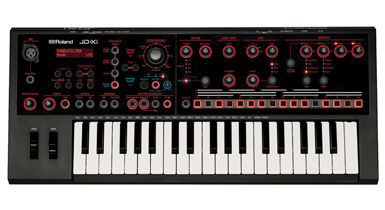
Welcome to the MusicTech Essential Guide. We’ve looked at the sound signal chain and inside the computer – now to the piece of music technology that’s finding itself at the heart of more music than ever before: the synthesiser…
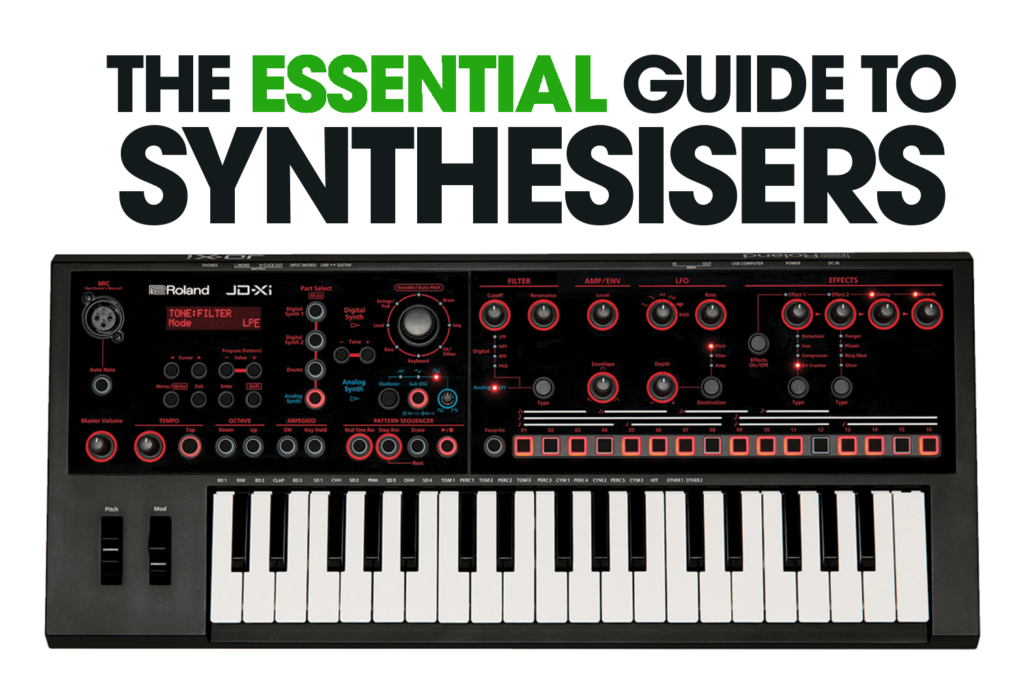
We’ve concentrated on a lot of what happens with the mechanics of music technology and production in our series of guides so far, discussing the software you need and the signal flow of microphone to monitor for the recording and mixing process.
Now, though, we’re going to look at a more fun aspect – gear that just makes some noise… but what noise it makes! This time around, we’re going to focus on one of the most important instruments in the history of music production: the synthesiser.
The synthesiser is a key instrument in music tech for two reasons. Firstly, the sound of the synth is used in so many different types of music production, from fantastical film scores to No. 1 pop tunes.
TPlus, we should think about the technological development of the synth, which has been a topsy-turvy tale of analogue to digital and back again – it’s a development history that very much mirrors that of the recording technology world.
We’ll run through a very brief history of the instrument in a moment and we’ll detail the different types of synth that you can get – in hardware, software, analogue and digital – plus, we’ll take a look at the basic sound-synthesis process.
We’ll even touch upon the Eurorack/modular-synth phenomenon, although that deserves its own Essential Guide at some point, so we won’t dwell on it too long. For this special guide, the synths that we will mainly focus on will be self contained, all-in-one hardware keyboard versions and not the more DIY, million-possible-combinations of the modular Eurorack world.
A very brief history
You can, should you wish, trace the synthesising of sound back to the late-19th century, with an instrument called the Telharmonium. Various other ‘ium’ ending names pop up in later years, including the 1930s Trautonium (powered by the freshwater fish), and the Mixturtrautonium from 1952. These were more mechanical devices and, without wishing to ignore that part of the instrument’s history, we’re going to jump to the electronic synthesiser – the more direct parent of today’s machines.
A roomful of electronics was developed by RCA in the 1950s and called the Electronic Music Synthesizer Mark I, but it was Don Buchla and Robert Moog who must take the major credit and be lauded as the godfathers of the modern synthesiser as in the 60s, both of these pioneers separately developed voltage-controlled modular-synth systems.
It was the music that bought the synth to the masses, though. Wendy Carlos’ Switched-On Bach used those Moogs to great effect and was the first notable synth recording (after several sci-fi film soundtracks). The Beatles and Beach Boys were early fans, as it was generally those with money who could indulge in the synth – these were not cheap machines when they were first developed.
Luckily, a certain Ralf Hütter and Florian Schneider had pockets deep enough and minds imaginative enough to invent synth pop with Kraftwerk (and electro, techno and dance music in general, many would have you believe) and released a whole series of legendary albums: from 1974’s Autobahn to 1981’s Computer World.
While Kraftwerk were pretty much changing the face of music, the Brits were involved, too, lapping up Moog, ARP, Yamaha and Sequential Circuits synths as their prices came within reach of mere mortals during the 70s.
Brian Eno and David Bowie were all over synths (albeit in Berlin), while The Human League and Cabaret Voltaire were like synth gangs from Sheffield, but the sound remained pretty underground until Gary Numan stumbled upon a Moog that was left switched on in a studio, pressed a note and Are ‘Friends’ Electric? was born, a record that hit the top of the charts, sold entire factory-loads of eyeliner – and launched a thousand synth-pop duos.
More companies were getting involved now and prices started to tumble. Roland accidentally invented house music with a bassline synth called the TB-303. Originally released in 1983, it was designed to provide bass accompaniment for guitarists, but tell that to the producers in Chicago, Manchester, Sheffield, Detroit and London who royally abused it until it squealed so loud that a whole underground acid movement started. This soon became overground, ultimately leading – by way of a few thousand dance genres – to the EDM of today.
The synthesiser is now everywhere. As well as still playing that key filtered and resonating role in dance music, it provides much of what we hear in pop, soundtracks films, TV and radio shows, anything in fact. It’s not all about synth pop any more – the sound of the synth has invaded all of our musical walks of life. So what exactly, then, is a synthesiser?
Save £££ by going soft
We’re not focusing too much on software synths here, but they do have their place at replicating hardware. Take the most coveted synthesiser around, for example. If you can find a Yamaha CS-80, expect to pay well into five figures for it, as it’s probably the most desired classic synth out there… and a mighty piece of furniture to boot.
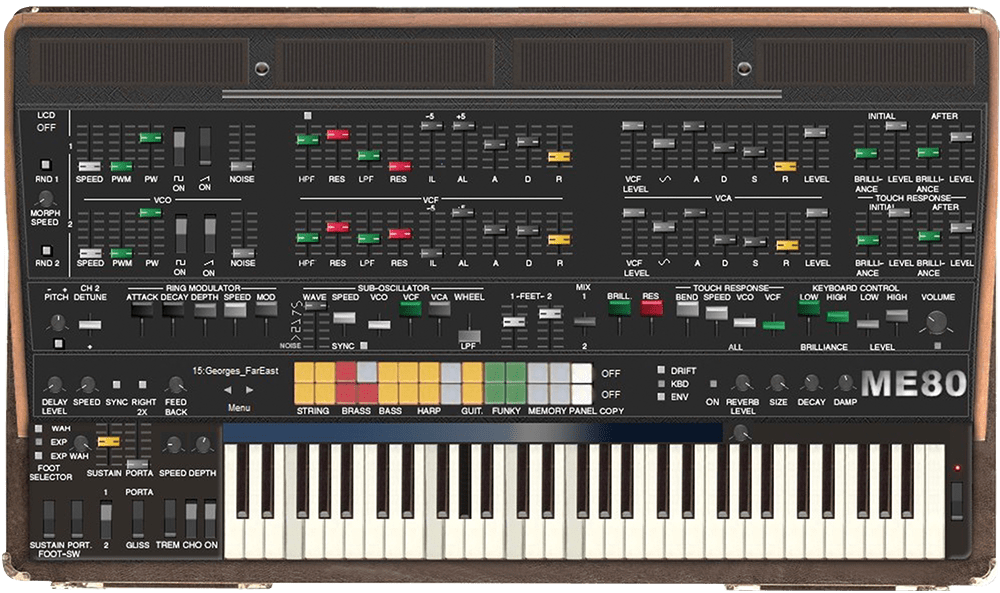
Luckily for every antique classic synth, there’s a cheap software synth alternative aiming to reproduce the original – at least in terms of knobs, buttons, colours and sliders – to perfection. Above is the ME80, a CS-80 synth that comes free with MixCraft Pro Studio.
Synth types
On a very (very) basic level, a synthesiser is all about grabbing a soundwave and manipulating it. They create these waves using oscillators, manipulate them with filters and modulators, and then amplify that sound with amplifiers. Don’t worry, this isn’t go to get any more technical than that. There are analogue ways of doing this, which most synth heads will tell you give a purer result, and digital ways of doing it, which get you a more varied result.
To muddy the water there is virtual analogue, a format favoured by Roland and Nord – which both create amazing ‘analogue’ synths that aren’t, really – but they’re the best digital emulations of analogue you can get. So far, we’ve been talking hardware – keyboards or sound modules you play with traditional black-and-white notes and machines that costs anything from a few hundred pounds to a few thousand.
We should briefly mention those vintage analogue synths made from the 60s onwards. These can, and still do, fetch tens of thousands of pounds and demand for them never seems to diminish, so some companies are trying to emulate them using newer hardware components. Or, in some cases (stand up, Moog), by simply restarting the production of the original machines. There’s also a big market in recreating classic synths in software…
Anatomy of a synthesiser module
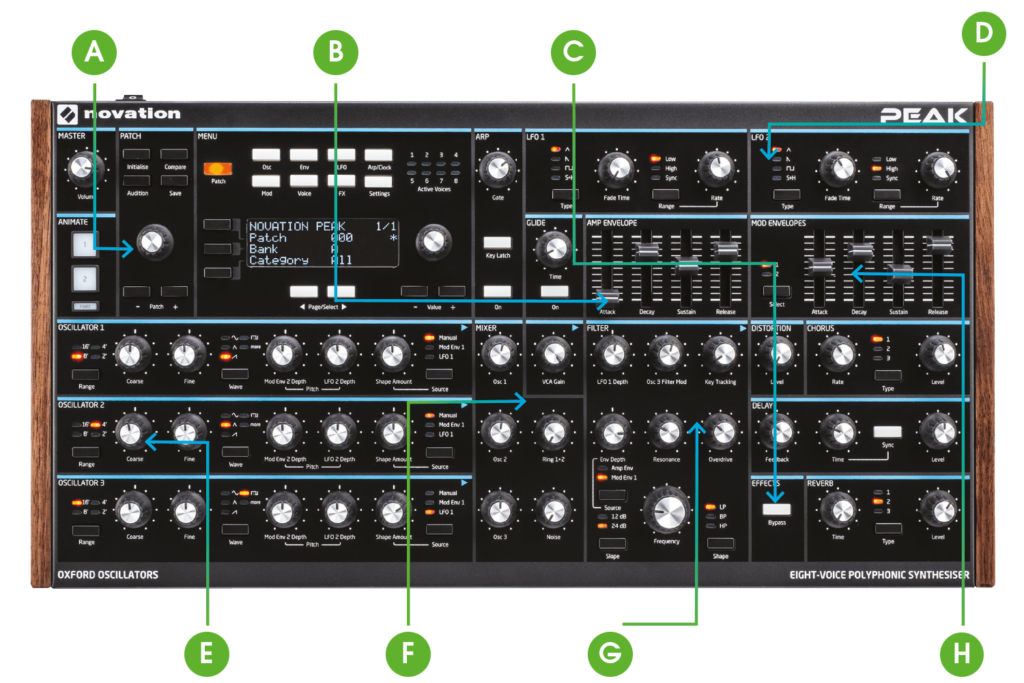
A) Presets Most synths now come bundled with hundreds of different sounds, but you can always edit these to create your own and save them.
B) Amp envelope This determines the shape of a note: how quickly it comes in (Attack), how long it lasts (Sustain) and fades out (Decay and Release) – also known as ADSR for short.
C) Effects Many synths have a range of effects you can apply to your sound. In this case, there are Reverb, Delay, Chorus and Distortion options, but these will vary.
D) LFO (Low frequency oscillator) These are different from the three oscillators and generate slow or fast waveforms that can offer a throbbing wow or speedy flutter to a sound.
E) The oscillators Your signal starts here – with the oscillators generating the waveform of the sound. In this case, there are three, and you can pitch your notes up and down with Coarse and Fine tuning controls.
F) The mixer A simple mixer section allows you to adjust the levels from the oscillators and with the example synth we’ve used here, you can add a bit of white noise and ring modulation to the action as well.
G) Filter Many would argue that this is the most important part of a synth, one that dictates a lot of the overall character of your sounds. Twist the filter and resonance knobs for that ‘meooow’-type of sound.
H) Modulation Most synths will allow you to apply certain parameters (sources) to others (destinations) – so you could apply, for example, LFO1 to the Filter, to create some wobbling frequency changes.
Then it all went soft
Around 20 years ago, computers became powerful enough to recreate a lot of what synths could do in software and in real time. The plug-in synth was born, and there are literally thousands of these around now, as we saw back in issue 173.
Without the restrictions of hardware, soft synths can do anything; from emulating some of those expensive vintage synths, to producing sounds never heard from machines impossible to physically build in the real world. Want a thousand oscillators and hundreds of filters? You’re bonkers if you do, but you can (probably) do it in software, should you so wish.
Software synthesisers (check out the 12 best currently available) are also a lot cheaper to produce than hardware machines and now, most DAWs you buy for producing music come bundled with a whole suite of soft synths and other virtual instruments. There’s also a very vibrant freeware community, and there are lots of freeware synths to be picked up for zero outlay. We rounded up some of those a couple of months back.
Anatomy of a soft synth
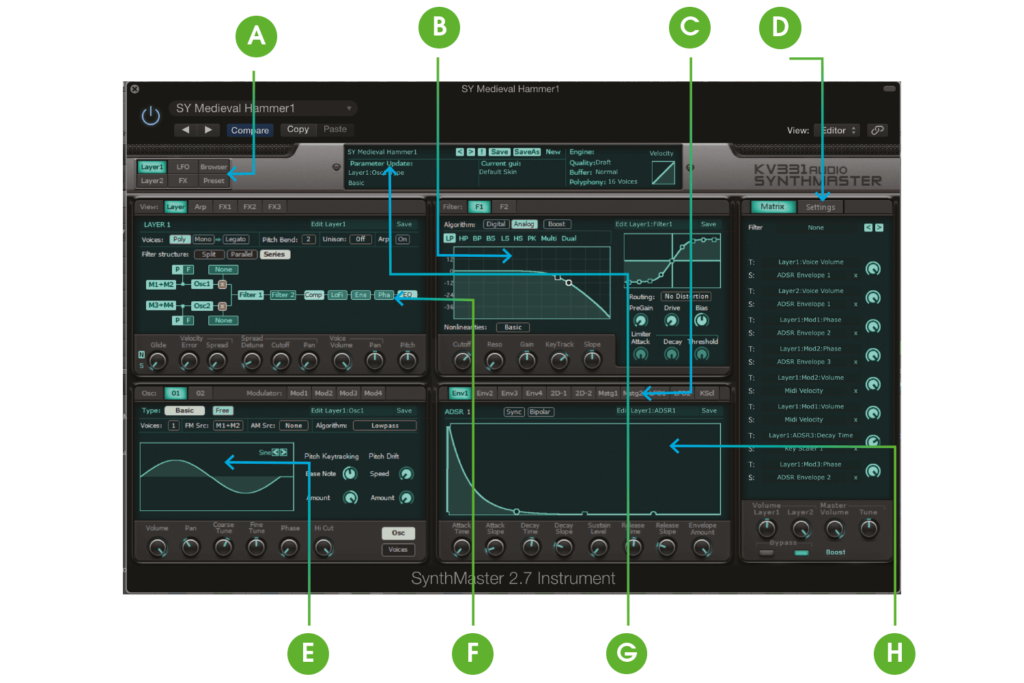
A)Tabs with many options Without the restrictions of hardware, a soft synth can be a lot more complex, with layers of features – in this case, signal flow and FX – placed behind tabs.
B)More graphics With click-and-grab graphics, you can easily define shapes and parameters – in this case, for the Filter. Again, more tabs are available to select other options.
C)Complex, but simple, too With clever design like this, the soft synth may have lots of extra controls over hardware, but they’re accessed by tabs again, so the fascia doesn’t get too complex.
D)Modulation options You don’t necessarily get more modulation options with a soft synth, but they can be more clearly laid out, to make selecting multiple ones easier.
E)More oscillator options Although this example is a humble Sine wave, with any digital synth, waveforms for source oscillators and routing options are often more sophisticated than their hardware equivalents.
F)A picture tells a… And one of the best uses of software graphics is to show you how the signal flows through the synth itself, just one of the reasons SynthMaster won our Best Soft Synth Award in 2016.
G)Presets You might have guessed this already, but virtual synths like this one come packed with many, many presets – almost too many to choose from, in some cases.
H)Graphical envelopes Those point-and-click parameters also come into their own when shaping how a note acts in time – its envelope can be moulded into shape and refined here.
Then hardware came back
A combination of a yearning for hands-on control, a need for proper analogue sound and software piracy meant that hardware synthesis has made something of a return over the last decade. As good as soft synths still are, many companies have had to introduce mind-numbing levels of anti-piracy registration and download steps to keep the format viable. And many people who have used soft synths on either a desktop, laptop or tablet device have missed the tactile feedback afforded by ‘the real thing’.
Also, the move back to hardware has been greatly accelerated by the modular-synth industry, which has seen hundreds of small hardware-synth developers start producing individual synth components – filters, oscillators, effects and much more – which you can use to create your own, unique synths. These companies can be anyone and everyone, from one-man band operators, making synth components in their garages, right up to major, traditional players in the synth game.
The truth is that we live in probably the most exciting time for synthesisers and have access to anything we like – analogue, digital, hard or soft. We can buy new analogues for silly money (whereas they were thought too expensive up until a few years back).
There are mobile synths to play, modules, keyboards, grooveboxes and even synth calculators. So we have a specially extended Buyer’s Guide this issue, covering every piece of synth hardware we have reviewed in MusicTech that’s still currently available. Enjoy!